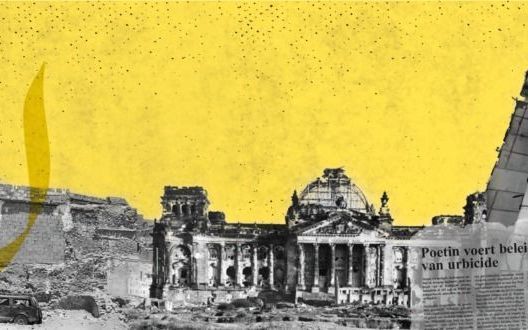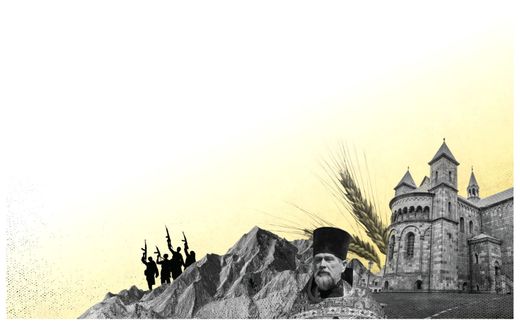Killing a city as a strategy of war
11-07-2022
Opinion
Jakob Hoekman, RD

Photo Corné van der Horst
Opinion
A merry-go-round for children next to a burned-out car. Houses shot to pieces in the background. The image is stuck in my head. I saw this scene in Mosul, Iraq. Mosul was the capital of the Islamic State in Iraq up until 2017. Its prolonged liberation left the city utterly destroyed.
Quite a bit of eastern Mosul has been rebuilt since then. However, as soon as you cross the Tigris River and enter the old city, the devastation is everywhere. Accompanied by a Christian woman, a native of Mosul by birth, I went back to her house in the old city. Or what was left of it. Weeping, she stood on the rubble. Only the entrance gate was still standing. On it, the Arabic letter "N" was still visible. The N means 'Nasrani', the word the Quran uses for Christians. IS deliberately marked Christian homes with an N. These houses were then used by IS for whatever suited them.
Urbicide
The ruins of Mosul reminded me of that other IS capital I once visited. The Syrian city of Raqqa. As well as Aleppo, also in Syria. Nowhere did I see urban destruction on such a large scale than in these three cities.
Today, one can add Ukrainian cities like Mariupol and Bolshaya to this macabre list. It is a number that will keep growing as long as we have weapons capable of large-scale destruction at our disposal. There is even a name for this: 'urbicide'. It is best translated from Latin as 'murdering a city'.
Now you could say that urbicide is as old as mankind. In a way, that's true. "By the way, I think that Carthage should be destroyed," is how Roman senator Cato ended all of his speeches. In 146 BC, three years after his death, Carthage was indeed destroyed by Rome.
The infamous destruction of Jerusalem by the Babylonian ruler Nebuchadnezzar predates this even further. Jewish prophets like Jeremiah extensively announced and lamented this urbicide.
Sarajevo
Yet it is only in the last thirty years that urbicide has gained prominence as a scientific term. The reason is that the means of deliberately destroying a city on a large scale have dramatically increased. It was especially after the destruction of Sarajevo during the Balkan wars of the 1990s that urbicide became a prominent topic. Martin Coward is a leading expert on the subject. He says that urbicide is specifically about erasing differences. Suppose you have a dictator who wants to get rid of people who repeatedly rebel against his policies. Then you have to destroy the places where you can find those dissenters. Hence, the murder of a city can be part of a deliberate strategy.
According to researcher Aaron Clements-Hunt, it is evident that Russian President Putin is deliberately pursuing a policy of urbicide in this regard. From the beginning of the war, Russia has fired thousands of missiles at urban targets, some of which are far from the front line. The result is a flood of refugees that should weaken Ukraine.
Hiroshima and Nagasaki
It is also possible that there is a planned demographic change behind it, by driving the "wrong" people out of a city and eventually replacing them with others. At least, that is the case in Syria. The Sunni neighbourhoods in Aleppo that were most critical of Syrian President Assad have been hit the hardest. All with Russian aid. Reconstruction has not even begun yet, so hundreds of thousands of Assad's critics have had no choice but to leave.
Clements-Hunt predicts that the Russian campaign of urbicide will not lose momentum for the time being. In fact, according to the researcher, urbicide is a core tactic in Russian military doctrine. Russia did exactly the same thing in Afghanistan, in Chechnya, and especially in Syria. In this respect, not only do Aleppo and Mariupol look equally ravaged, but behind the industrial destruction of these cities is one and the same man: Putin.
However, it is too easy to place all all of the blame for urbicide on autocrats like Putin and Syrian President Assad. Large-scale urban destruction by modern weapons did not begin in Mariupol nor in Aleppo. The foundation was laid in World War II, during which both the Germans and the Allies razed entire cities to the ground. Think of Rotterdam at the beginning of the war. But you can also think of cities like Berlin and Dresden. Particularly the latter city has become the symbol of ruthless urbicide - committed not by the "wrong" side, but by the "right" side of history.
Not much later, the cities of Hiroshima and Nagasaki were obliterated by atomic bombs. It was the only time ever that atomic bombs had been used against entire cities. That ultimate form of urbicide was committed not by Russia but by the United States.
Because urbicide on a large scale is still so new, there is really not yet a proper condemnation of it in international laws. Many experts consider the deliberate destruction of cities to be a form of genocide. This, of course, is extensively condemned in international law. However, genocide is sometimes difficult to prove, whereas the deliberate destruction of cities can be. Russia's actions in Ukraine may well give the term urbicide leverage in international criminal law.
But those who think of it as an extra means to condemn autocrats like Putin should think twice. Democratic societies have a track record themselves when it comes to committing urbicide.
This article was translated by CNE.news and previously published in Dutch daily Reformatorisch Dagblad on June 20th, 2022.
Related Articles






